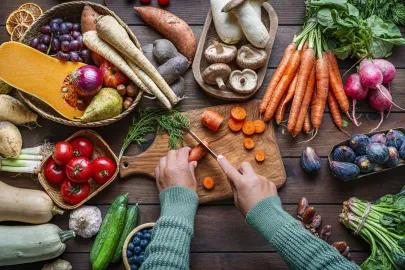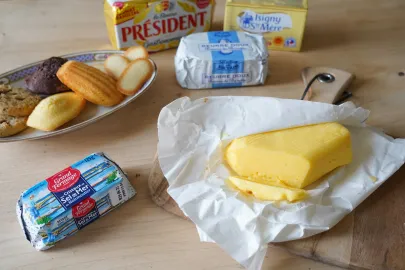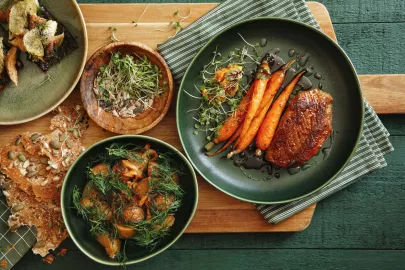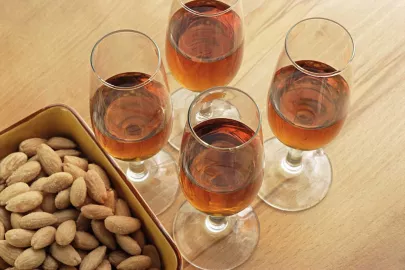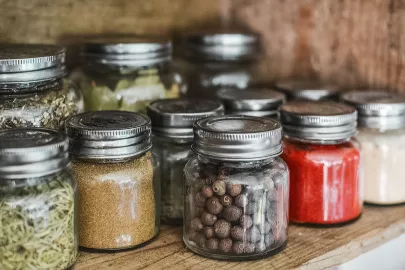Traveling to France may be off the table for the foreseeable future, but that doesn’t mean you can’t get your fill of French cuisine at home. Sometimes, adding a taste of French flare to your next meal is as easy as using an extra ingredient.
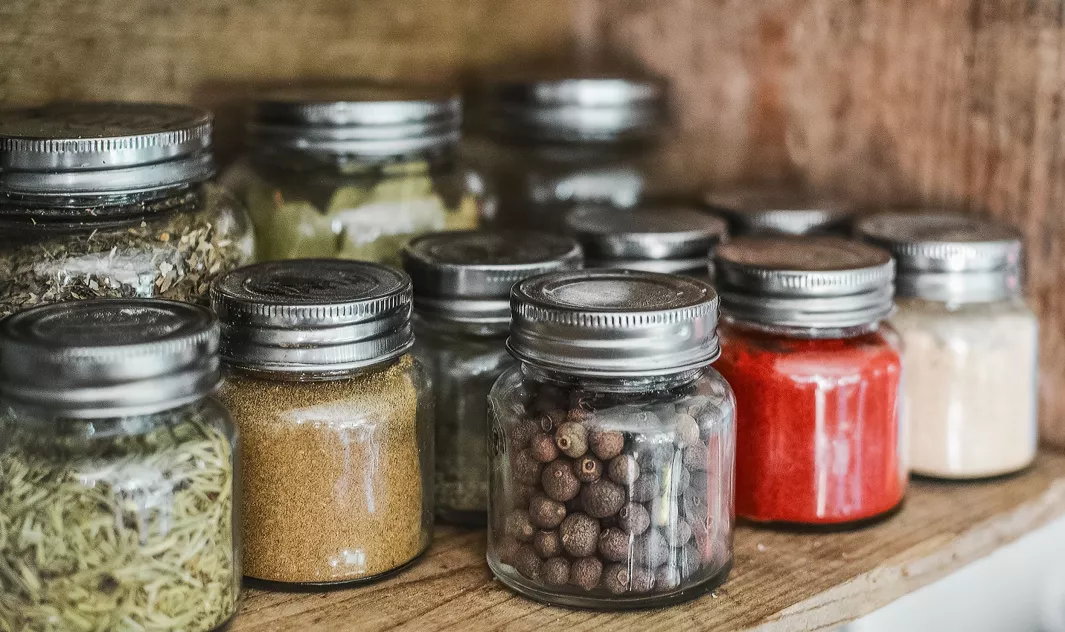
We’ve rounded up nine signature French flavors to add to your plate the next time the pang for French-inspired gastronomy hits. Simply snag some fresh herbs, sprinkle some seasoning, and get ready to be mentally transported to your favorite wicker bistro set in the City of Lights.
Herbes de Provence
This may sound simple, but adding a handful of herbes de Provence is the perfect way to French-ify any basic dish. Simply mix oregano, rosemary, and thyme together in a small bowl and sprinkle on a variety of roasted meats and veggies prior to putting in the oven. (Sage, thyme, dill, and/or lavender are also welcome additions). You really can’t go wrong here.
Suggestion: The rusticity of herbes de Provence makes them ideal for using while cooking rather than seasoning at plating. We recommend rubbing these herbs on meats prior to grilling/roasting or adding them into soups and stews to allow them to work their magic (the latter will allow their aromas to soften, integrate, and show their best).
Persillade
Adding a dose of this classic chopped parsley and garlic mixture is the perfect way to make any dish pop. Whether butter or olive oil is your base of choice, simply mix in some S&P and get ready for a serious dose of flavor.
Suggestion: For an easy yet absolutely delicious use of persillade, simply toss with some russet potatoes and roast in the oven. For ambitious at-home chefs, try your hand at whipping up some homemade escargots -- if you’re pining for a taste of Burgundy, this is most definitely your route.
Lavender
Call us stereotypical, but lavender is one of the most sensual, satisfying, and seriously delicious flavors on the planet. It’s no surprise that the French (and really everyone) go crazy for it. Synonymous with the south of France, this gorgeous herb is as wonderful in foods/beverages as it is in your hand soap, laundry detergent, or living room candles.
Suggestion: Although potent, lavender is pretty versatile in its culinary uses. In dried formats, we suggest rubbing this purple-hued herb on chicken or other poultry for an added boost of flavor. In syrup form, this flavor is delicious for sprucing up lattés and other warm beverages -- and for those with at-home ice cream makers, whipping up some lavender ice cream or gelato is perhaps the most mouthwatering use of this herb that we can think of!
Marjoram
This Mediterranean herb is a staple in southern French cooking. Marjoram’s earthy flavor is similar to that of thyme, though with a bit more of a woodiser and spicier kick. Marjoram is sometimes added to herbes de Provence, though we recommend experiencing this signature spice on its own.
Suggestion: Whether mixed into your next salad, sprinkled atop your favorite pizza, or thrown into your next homemade soup, there’s really nothing that this delicious spice won’t improve.
Bouquet Garni
This ‘garnished bouquet’ of herbs is made up of sage, thyme, parsley, bay leaf, and the occasional peppercorn. Simply tie the fresh herbs together with a butcher’s string and plop into your next slow-cooker recipe. (Note: tying the herbs together is key here, as this allows for easy removal -- and no stems/leaves left behind -- in your final dish).
Suggestion: This bouquet of herbs is the perfect addition for stocks, soups, and a variety of slow-cooker recipes. Your at-home chilis just got a whole lot more interesting.
Vadouvan
Never heard of Vadouvan? We can’t wait to introduce you to this delicious seasoning. This French-style ‘curry’ is made from a combination of turmeric, cardamom, black pepper, onion, garlic, and fenugreek. All ingredients are most commonly dried, pounded, and ground into a textured blend of spices. When mixed with oil and/or water, the seasoning will become more paste-like.
Suggestion: Vadouvan can really be used on any base. Whether meat, seafood, or veggies are on the menu, this savory spice adds a delicious and unique twist to any hearty base.
Fleur de Sel
Don’t say it’s just salt! There’s something undeniably French (and delicious) about adding a touch of coarse sea salt to the top of a dish. This crunchy seasoning is an instant upgrade to the run-of-the-mill white stuff found in your kitchen shaker. Simply grab a pinch, sprinkle, and get ready for an instant transport to the saline-tinged shores of the south of France.
Suggestion: There really isn’t a dish that a pinch of fleur de sel de Guérande won’t amplify. However, use sparingly! This pungent salt packs a serious punch.
Fines Herbes
As the name suggests, these ‘fine herbs’ are less rustic than the classic herbes de Provence mélange. Unlike the powerful flavors of rosemary and oregano, fines herbes are less aggressive on the palate and are generally made up of tarragon, parsley, chervil, and/or chives. Because of their delicate nature, this herb addition tends to do best when sprinkled atop a dish prior to serving (rather than using while cooking). Thyme is frequently added to the mix, as is marjoram, though this will result in a more savory and robust final mixture.
Suggestion: Sprinkle a taste of fines herbes atop cooked poultry, fresh salads, or omelettes for an extra burst of French flavor.
Quatre Épices
This versatile ‘four-spice’ mix is used in a variety of savory cuisines. Composed of pepper, cloves, ginger, and nutmeg, this versatile spice is most commonly used to flavor soups, terrines, and a variety of stews. For instant crockpot upgrades, this is your go-to spice.
Suggestion: The sweet undertones found in quatre épices make it ideal for using with sweet meats and hearty root vegetables (think squash, pumpkin, turnips, and more). This fall, forget the pumpkin spice -- quatre épices is where it’s at.
Everything You Need to Know about Traditional French Herbs
What Are French Herbs?
Traditional French herbs are the backbone of French cooking, adding depth, balance and freshness to dishes. The classics are thyme, rosemary, tarragon (French tarragon), parsley (persil), chervil (cerfeuil), chives (ciboulette). Other staples like basil, fennel, bay leaf and marjoram are used to flavor soups, sauces and roasted meats. Lavender and savory are in Provençal mixtures, sage and mint for more robust dishes. Whether fresh or dried, they are essential to the French flavors.
How to Use French Herbs in Cooking?
French herbs can be used in many ways to flavor and enhance your cooking. For a traditional touch use herbes de Provence, a classic French blend of dried herbs like thyme, savory, marjoram and rosemary to season grilled chicken, vegetables or fish.
Fines herbes — a delicate mix of parsley, chives, chervil and tarragon — is perfect for lighter dishes like omelette aux fines herbes or fresh salads. A bouquet garni a bundle of herbs tied together is used to flavor soups, stews and stocks.
Sprinkle chopped fresh parsley or chives over egg dishes or roasted vegetables as a finishing garnish.
For marinades stir in herbs like tarragon and mint which go beautifully with meat and fish.
French herbs can also be grown from seeds for a rewarding and aromatic addition to your garden. For indoor growing, consider using planters or herb kits that allow for year-round harvesting. Whether in your garden or your kitchen, growing these herbs ensures you’ll always have fresh or dried herbs on hand for cooking.
What to Cook with French Herbs
French herbs are used in many classic dishes that show off their subtle yet bold flavors. Here are a few:
- Ratatouille: A vegetable stew with tomatoes, zucchini, eggplant and herbes de Provence.
- Omelette aux Fines Herbes: A light omelet with chervil, parsley, chives and tarragon.
- Grilled Chicken or Fish: Thyme, fennel and a splash of vinegar
- Potatoes: Roasted with rosemary or persillade (garlic and parsley mix)
- Veal and Lamb: French tarragon or thyme with these meats is lovely, it adds freshness and depth.
What Are French Herb Blends?
French cuisine is all about herb blends, which combine multiple herbs to create signature flavors. Here are the most popular French herb blends:
- Herbes de Provence: A mix of dried thyme, savory, basil and lavender—perfect for grilled meats and vegetables.
- Fines Herbes: A delicate blend of fresh chervil, parsley, chives and tarragon—use in omelets, salads or as a light garnish.
- Bouquet Garni: Herbs like thyme, bay leaf and parsley tied together or in a small bag—use in soups, stews and sauces.
- Persillade: A mix of chopped fresh parsley and garlic—use to flavor potatoes or lamb.
- French Herb Salt: A blend of rosemary and thyme mixed with salt—use to season vegetables, fish or meat dishes.
These blends are part of French cooking, simple and elegant ways to add flavor to many dishes.
Where to Buy French Herbs?
You can buy French herbs at specialty shops or gourmet markets. They come fresh in bunches, dried in jars or bags and sometimes as pre-mixed blends like herbes de Provence. Many stores also sell organic or high quality herbs, so you get the best flavor. For convenience French herbs are also available to buy online through Amazon or gourmet food suppliers. A French herb mix makes a great gift for foodies and those who want to try French flavors at home.
How to Grow French Herbs?
Growing a herb garden at home means you have fresh herbs at your fingertips. Herbs like chervil, tarragon, thyme and fennel are perennial herbs that love sunny spots. Plant these herbs in well drained soil outside in the summer or small pots of chives and parsley indoors on a sunny kitchen windowsill.
Contributor

Editor

